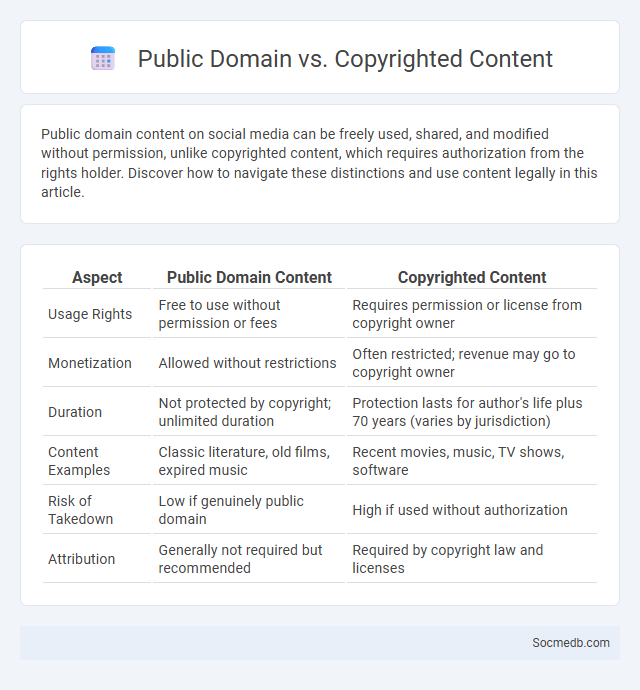
Photo illustration: Public Domain vs Copyrighted Content
Public domain content on social media can be freely used, shared, and modified without permission, unlike copyrighted content, which requires authorization from the rights holder. Discover how to navigate these distinctions and use content legally in this article.
Table of Comparison
| Aspect | Public Domain Content | Copyrighted Content |
|---|---|---|
| Usage Rights | Free to use without permission or fees | Requires permission or license from copyright owner |
| Monetization | Allowed without restrictions | Often restricted; revenue may go to copyright owner |
| Duration | Not protected by copyright; unlimited duration | Protection lasts for author's life plus 70 years (varies by jurisdiction) |
| Content Examples | Classic literature, old films, expired music | Recent movies, music, TV shows, software |
| Risk of Takedown | Low if genuinely public domain | High if used without authorization |
| Attribution | Generally not required but recommended | Required by copyright law and licenses |
Introduction to Intellectual Property
Understanding intellectual property (IP) is essential for protecting your creative content on social media platforms such as Facebook, Instagram, and TikTok. Copyrights, trademarks, and patents safeguard original works, brand identity, and innovative ideas from unauthorized use or distribution. You can maintain control over your digital assets by learning how IP laws apply to online content sharing and creation.
Defining Public Domain Content
Public domain content on social media refers to creative works no longer protected by copyright, allowing unrestricted use, sharing, and modification by users. Examples include government publications, expired copyrights, and works explicitly released into the public domain. Leveraging this content can enhance social media campaigns without legal concerns or licensing fees.
Understanding Copyrighted Content
Understanding copyrighted content on social media is crucial for protecting Your intellectual property and avoiding legal issues. Platforms often use automated systems to detect unauthorized use of copyrighted material, which can result in content removal or account penalties. You should always seek permission or use properly licensed content to ensure compliance with copyright laws.
What is a Copyright Claim?
A copyright claim occurs when a content owner asserts their legal rights over their original work used on social media platforms without permission. Your videos, images, or music can be flagged if they include copyrighted material, leading to restrictions or removals. Understanding these claims ensures you protect your content and avoid potential penalties or loss of monetization.
Key Differences: Public Domain vs Copyrighted Content
Social media content in the public domain is free for anyone to use, modify, and distribute without obtaining permission, whereas copyrighted content is protected by intellectual property laws requiring users to seek authorization or licenses before use. Public domain materials, including expired copyrights and works explicitly released, offer unlimited sharing potential, while copyrighted materials demand adherence to restrictions to avoid infringement. Understanding these distinctions is essential for creators and marketers to ensure legal compliance and maximize content utility on platforms like Facebook, Instagram, and Twitter.
How Works Enter the Public Domain
Social media content enters the public domain when copyright protection expires, typically 70 years after the creator's death or 95 years from publication for corporate works. Once in the public domain, Your ability to freely use, share, and modify posts, images, or videos without legal restrictions increases significantly. Understanding these timelines helps leverage public domain materials for creative and marketing purposes effectively.
Legal Implications of Using Copyrighted Content
Using copyrighted content on social media without permission can lead to legal consequences, including copyright infringement claims and potential financial penalties. Platforms often implement automated tools like Content ID to detect unauthorized use, which may result in content removal or account suspension. Understanding your rights and obtaining proper licenses ensures your social media activities comply with copyright laws and protect your online presence.
Responding to Copyright Claims
Responding to copyright claims on social media requires understanding the platform's specific procedures and timelines for disputes. You must provide accurate evidence supporting your right to use the content, such as licenses or fair use rationale, to ensure a proper resolution. Efficient handling of these claims helps protect your account and maintain your online reputation.
Best Practices for Content Usage
Maximize your social media impact by tailoring content to platform-specific formats and audience preferences, ensuring higher engagement and reach. Utilize high-quality visuals and concise, compelling captions aligned with your brand voice to maintain consistency and authenticity. Schedule posts during peak user activity times and incorporate analytics to refine your strategy for optimal content performance.
Conclusion: Choosing Safely Between Content Types
Selecting the right social media content type depends on your audience's preferences and platform algorithms, ensuring higher engagement and reach. Video content typically generates more interaction, while images offer quick visual appeal and text posts encourage discussions. You must analyze performance metrics regularly to safely choose content types that maximize your social media success.
 socmedb.com
socmedb.com